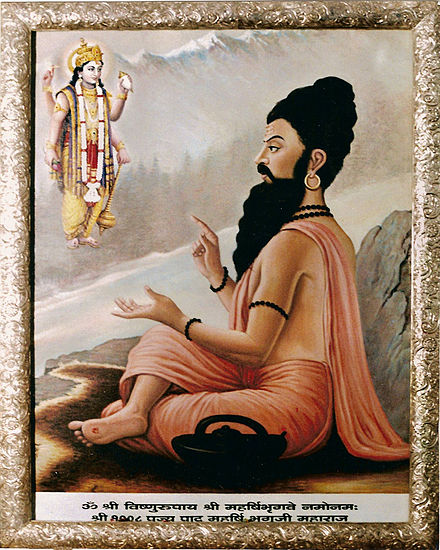
The Pancha Kshetrams (Sanskrit: पञ्च क्षेत्रम्, romanized: Pañca Kṣetram, lit. 'Five abodes/stages of Vishnu') or Pancha Bhargavi Kshethram is a group of five sacred Hindu temples in India, dedicated to the deity Vishnu and Lakshmi With the legend associated to the Venkateswara Temple, Tirumala. All the temples are Divya desams except one which is an Abhimana Kshethram.
During Kali Yuga, Narada advised some sages who were performing yagna to decide who could be given the fruits of yagna among Trimurtis (Brahma, Vishnu and Shiva). Bhrigu was sent to test the Trinity. The sage who had an extra eye in the sole of his foot visited Brahma and Shiva and went unnoticed in both these locations. He cursed Brahma to be not worshipped and Shiva to be worshipped as a lingam. At last he visited Vishnu and the lord acts as if he had not noticed Bhrigu. Getting angered by this act, sage Bhrigu kicked Vishnu in the chest, to which Vishnu did not react and instead apologised to the Sage by massaging his feet. During this act, he squashed the extra eye that was present in the sole of Bhrigu's foot. However Lakshmi finds it as an insult since Vishnu's chest was considered as Lakshmi's residence (vakshasthala) and Bhrigu kicked it which indirectly insulted Lakshmi. She then left Vaikuntha and came to Earth to Tirumala and started meditating in human form as Padmavati.[1]
Vishnu bore human form as Srinivasa, left Vaikuntha, in search of Lakshmi, reached the Seshachalam hills in Tirumala and started meditating. Lakshmi learned of the condition of Srinivasa and called Shiva and Brahma. Shiva and Brahma then converted themselves into a Cow and a Calf and Lakshmi had handed over the cow and calf to the Chola king ruling over Tirumala Hills at that time. The Cow would provide milk to Srinivasa daily while it was taken for grazing. One day, a cowherd in the Chola king's household saw this, and tried to beat the Cow with his staff, but Srinivasa bore the injury, then struck down the cowherd. Angered by the cowherd's actions, Srinivasa cursed the Chola king to become an asura as dharma says sins committed by servants should be borne by their employers. The king prayed for mercy after which Srinivasa said to him, that the King should take next birth as Akasharaja and should perform marriage of his foster-daughter Padmavati with Srinivasa.[2]
Srinivasa went to his foster-mother Vakula Devi on Tirumala hills and stayed there for a while. After curse, the Chola king took rebirth as Akasharaja and he had a foster-daughter named Padmavati who is the human form of Lakshmi, who took this form in the Padmapushkarini situated at present day Tiruchanur at Tirupati in Andhra Pradesh. Srinivasa married Padmavati at present day Narayanavanam in Andhra Pradesh and returned to Tirumala Hills. After few months, Goddess Lakshmi and God Vishnu had discovered the marriage of Srinivasa with Padamavati and went to Tirumala hills to question Srinivasa and Padmavati. Srinivasa, unable to bear the quarrel between Lakshmi, Vishnu and Padmavati, turned into stone right when he was encountered by Lakshmi, Vishnu and Padmavati. Brahma and Shiva appeared before the confused deities and explain the main purpose behind all this - The Lord and Goddess' desire to be on the seven hills for the emancipation of mankind from the perpetual troubles of Kali Yuga. Goddesses Lakshmi and Padmavati with God Vishnu also turn into stone deities expressing their wish to be always there. Lakshmi stays with Him on His Chest on the left side while Padmavati rests on His chest's right with Vishnu also present at the side.
Padmavati got her memories and was still angry with Vishnu. In the meanwhile, the sage Bhrigu sought his apology and requested Lakshmi to be born to him in more 4 places which are Sundararaja Perumal Temple, Salem Bhrigu as Bhrigu, Nachiyar Koil Bhrigu as Medhavi Maharishi, Oppiliappan temple Bhrigu as Markandeya Maharishi and Sarangapani temple, Kumbakonam Bhrigu as Hema Maharishi.[3][4][5]
Venkateswara Temple, Tirumala is run by Tirumala Tirupati Devasthanams (TTD), which is under control of Andhra Pradesh Government. The head of TTD is appointed by Andhra Pradesh Government. The rest four temples in Tamil Nadu are maintained and administered by the Hindu Religious and Charitable Endowments Department of the Government of Tamil Nadu. The presiding deities are revered in the 5th century Tamil Vaishnavate canonical work, the Divya Prabandham, written by Tamil saint poets known as the Alvars and classified as Divya desam except one Deity which is one of the 108 Abhimana sthalam.